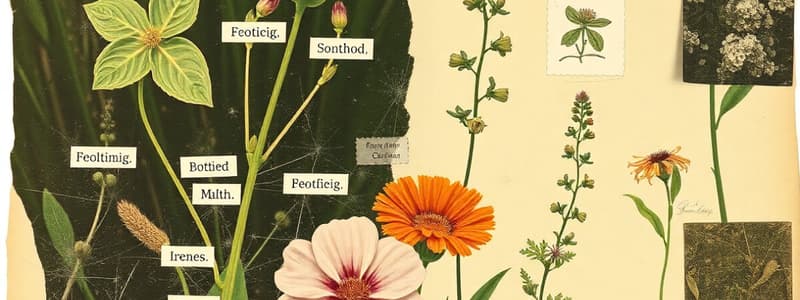Podcast
Questions and Answers
What primary purpose does plant labeling serve?
What primary purpose does plant labeling serve?
- Aesthetics of garden design
- Facilitating identification and education (correct)
- Increasing land value
- Providing recreational activities
Plant labels should be resistant to weather elements.
Plant labels should be resistant to weather elements.
True (A)
What essential information should a comprehensive plant label include?
What essential information should a comprehensive plant label include?
Common name, scientific name, species, cultivar, care needs.
A plant's ______ provides a universally understood identifier.
A plant's ______ provides a universally understood identifier.
Match the following components with their descriptions:
Match the following components with their descriptions:
What is important when creating labels for different audiences?
What is important when creating labels for different audiences?
Plant labeling is only necessary for botanical gardens.
Plant labeling is only necessary for botanical gardens.
What is one way to ensure labels are effective?
What is one way to ensure labels are effective?
Flashcards
Plant labeling
Plant labeling
Providing information about a plant, usually on a label attached to the plant.
Purpose of plant labeling
Purpose of plant labeling
Helps identify, learn about, and organize different plants.
Components of a plant label
Components of a plant label
Common name, scientific name, species, cultivar, origin, growth characteristics, care needs, and special features.
Common name
Common name
Signup and view all the flashcards
Scientific name
Scientific name
Signup and view all the flashcards
Species
Species
Signup and view all the flashcards
Cultivar
Cultivar
Signup and view all the flashcards
Consideration for effective plant labeling
Consideration for effective plant labeling
Signup and view all the flashcards
Study Notes
Defining Plant Labeling
- Plant labeling involves providing information about a plant, typically attached to or near the plant.
- This includes the plant's common name, scientific name, species, cultivar, and other relevant details.
Purpose of Plant Labeling
- Plant labeling facilitates identification, education, and plant cataloging.
- Accurate labels help differentiate species, varieties, or cultivars.
- This aids gardeners, horticulturists, and researchers for pest control, breeding, and conservation.
- Labels educate visitors at botanical gardens, nurseries, and other locations.
- Information helps with proper care and maintenance based on specific plant needs.
Components of Plant Labeling
- Common name (e.g., "Rose")
- Scientific name (e.g., Rosa spp.), a universal identifier.
- Species (e.g., Rosa canina), specifying the exact species.
- Cultivar or variety (e.g., "Hybrid Tea"), distinguishing variations within a species.
- Origin or source (e.g., "Local Nursery"), if applicable.
- Growth characteristics (e.g., "Full Sun"), special features.
- Care needs (e.g., watering, soil), specific to the plant.
- Distinctive features, pests, and diseases specific to the plant.
- Special care or handling requirements.
Considerations for Effective Plant Labeling
- Labels should be visually clear, using appropriate font size, color, and placement.
- Labels must be resistant to weather and durable for intended use.
- Accuracy is crucial; research and expert consultation are important to prevent errors.
- Maintaining a consistent template across labels ensures uniformity.
- Consider the audience and provide the appropriate level of detail.
- Labels should be easily viewed and touched, avoiding obscure or damaged locations.
Types of Plant Identification
- Plant labels come in various formats: tags, cards, etched metal plates, or digital identifiers.
- The format and medium should be chosen based on the location and expected use.
Studying That Suits You
Use AI to generate personalized quizzes and flashcards to suit your learning preferences.




